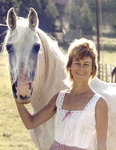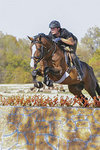

YACOLT – One of the best kept secrets in the United States horse world might be the Shagya-Arabian horse.
Despite over 200 years of selective breeding at the Bobolna Stud in Hungary, there are fewer than 300 purebred Shagya-Arabian horses in the United States.
On Sat., Sept. 4, up to a dozen Shagyas from around the Pacific Northwest will be at Winter Creek Farm in Yacolt for a breed inspection, an event held every three years to assess each horse to determine whether their quality and type meets breed standards.
According to the North American Shagya-Arabian Society (NASS), a Shagya should be beautiful and harmonious with an expressive head, well-formed neck, clearly defined topline, long croup and well-carried tail, as well as strong, clean legs. Ground consuming, elastic and correct movement at all three gaits is very important. A height of 14.3 to 15.3 hands and a cannon bone of not less than 7 inches are the standard.
The Shagya-Arabian horse shares bloodlines with the purebred Arabian, and can be of up to 9/16 Arabian lineage. However the Shagya breed is distinctly separate, and has been maintained in a separate studbook, or breeding record, for centuries.
The Shagya might never have become established in the United States at all were it not for one breeder, Adele Furby, now of Camp Verde, AZ. Furby was living in Montana and breeding Arabian horses when she began to study riding with several top dressage and eventing instructors. She longed for a horse with the power, calmness, and balance of the warmblood sport horse, but the intelligence, beauty, elegance, grace and toughness of Arabian horses.
In 1983, she spotted the writing of a German Arabian expert on Shagya horses, which explained that they had been developed in Austria and Hungary as an Arabian-bred horse suitable for military use and driving. She knew this was the horse she had been seeking.
After an extensive search, she discovered that in her own backyard the obscure Hungarian Countess Bessenyey was breeding “Hungarian horses” at her 22,000 acre Bitterroot Stock Farm. The family had lost their horses in Hungary during World War II, but soon after the Countess’ arrival in America, she was able to purchase nine horses from the U.S. Army Remount.
These were horses of several Hungarian breeds which had been captured by General Patton and the U.S. Army, a story best known from the Disney movie “The Miracle of the White Stallions,” which tells of the Lipizzaner horses which were rescued.
The horse that Furby later acquired from Bessenyey’s estate was the stallion Hungarian Bravo. He was 24 years old, and would become the foundation sire for Shagya Arabian breeding in the United States. Furby traveled to Germany, Switzerland, and Denmark and selected three Shagya mare and two stallions to import, and her Shagya breeding program was born.
Historically, breeding standards at the Babolna State Stud in Hungary were rigorous. First were a rigorous set of performance tests for both mares and stallions before they were accepted for breeding. This included a 480 mile ride in 10 days across plains, forest, and mountains, 2-mile sprints, and long-distance driving. Mares as well as stallions were sent to the headquarters of cavalry regiments near established hunt clubs and officers would ride them in the hunting field.
A careful record was made describing the horse’s jumping speed, condition, and disposition, as well as how good a keeper the horse was. Mares and stallions which did not meet high standards in these performance tests were all sold at auction. Besides strict culling and performance testing, the Hungarians used extensive progeny testing.
New desert Arabian stallions were bred to 30 mares for three successive years. These mares were made up of 10 of the stud’s best quality, 10 middle quality, and 10 of the lowest quality mares. At the end of the three year period, all 90 offspring were brought before the breeding committee for evaluation. If the offspring were not judged to be good enough, the entire group was sold.
NASS is recognized by the International Shagya-Araber Gesellschaft (ISG), the international body supporting the breeding and preservation of the Shagya-Arabian breed, as the official Shagya Arabian registry for the USA and Canada. Modern Shagya breed inspections in the United States seek to preserve the elegant type, great hardiness and toughness, endurance, and inborn friendliness toward humans that are sought in a modern riding horse. Inspections are held every three years, at up to six locations across the United States.
At a NASS inspection, each horse undergoes four phases of evaluation. First, their height, cannon bone circumference and girth circumference are measured. The horse is then shown standing still, on a “triangle” at a walk and trot, and free lunging at the trot canter and gallop. Jumping ability is evaluated by asking the horses to free jump through a chute. Marks are given on a scale of 1 to 10, and an average score of 7.0 is required for breeding approval.
A breed inspection is unusual for most U.S horse breeds, but it is a centuries old practice among European sport horse breeders. This rigorous registry process helps to increase the odds that offspring will consistently possess the desired qualities of the breed.
Guests are welcome at the upcoming inspection. The day’s schedule is pending at press time. Those interested in attending should call Winter Creek Farm at (360) 263-3995 to RSVP and obtain further details.